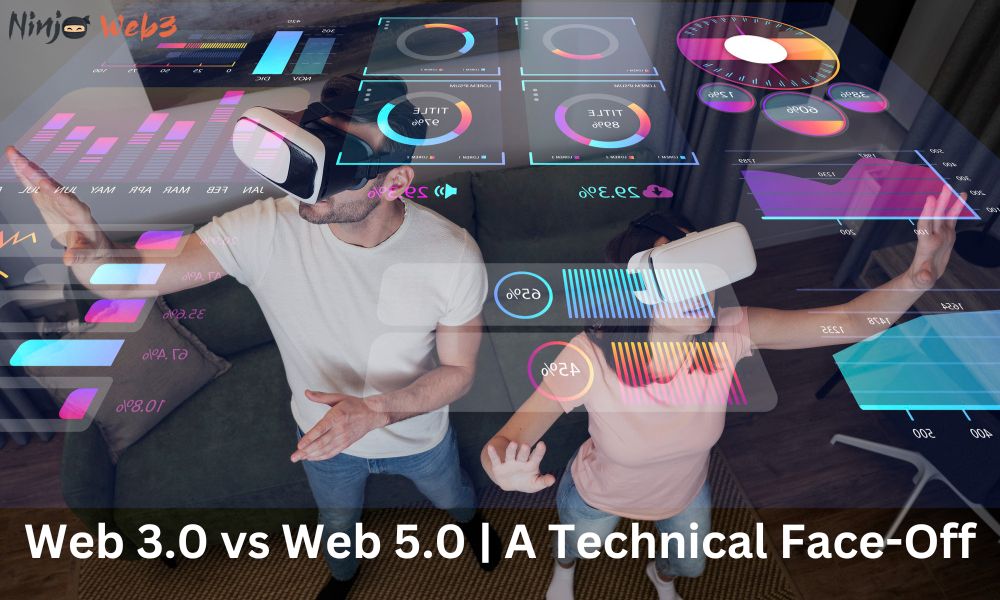Web 3.0 vs Web 5.0: A Technical Face-Off
 Ninja Web 3
Ninja Web 3
In the ever-evolving landscape of the internet, the concepts of Web 3.0 and Web 5.0 have emerged as pivotal milestones, each representing a significant leap in how we interact with the digital world. This blog aims to dissect the technical nuances of Web 3.0 vs Web 5.0, providing a clear understanding of their differences and implications.
Understanding Web 3.0
Web 3.0, often associated with the term "Semantic Web," is about creating a more intelligent and connected web experience. It leverages technologies like artificial intelligence (AI), machine learning (ML), and blockchain to enable more personalized, efficient, and secure web interactions.
Key Features of Web 3.0
Semantic Web: Enhancing web technologies to interpret and understand user data and behavior, enabling more relevant and contextual interactions.
Decentralization: Utilizing blockchain technology to decentralize data storage, enhancing security and user privacy.
AI and ML Integration: Leveraging AI to automate and personalize user experiences.
Example: Decentralized Application (DApp)
// A simple smart contract example in Solidity for Ethereum-based DApp
pragma solidity ^0.8.0;
contract SimpleStorage {
uint256 public storedData;
function set(uint256 x) public {
storedData = x;
}
function get() public view returns (uint256) {
return storedData;
}
}
This example represents a basic smart contract on the Ethereum blockchain, showcasing the decentralization aspect of Web 3.0. Users can interact with this contract without relying on a central authority.
Exploring Web 5.0
Web 5.0, while still largely conceptual, is anticipated to be the next iteration of the web. It's expected to build upon the foundations of Web 3.0, integrating advanced AI, 3D graphics, and immersive experiences, leading towards an 'emotive web'.
Anticipated Features of Web 5.0
Advanced AI: Even more sophisticated AI algorithms driving hyper-personalized content and interactions.
Immersive Experiences: Integration of virtual reality (VR) and augmented reality (AR) for more engaging web experiences.
Emotive Interaction: Technologies to understand and respond to human emotions for a more intuitive web experience.
Hypothetical Example: AI-Driven Personal Assistant
# Hypothetical Python code for an AI-driven personal assistant in Web 5.0
import ai_module
assistant = ai_module.createAssistant(name="Alexa 5.0")
assistant.train(data_source)
user_input = get_user_input() # Function to capture user input
response = assistant.respond_to(user_input)
print(response)
This hypothetical code snippet illustrates a more advanced AI-driven personal assistant, which could be part of Web 5.0's landscape. It would be capable of understanding and responding to user queries in a more human-like manner.
Web 3.0 vs Web 5.0: The Technical Face-Off
Technology Stack: Web 3.0 is built on blockchain, AI, and semantic web technologies. Web 5.0 is expected to extend this with more advanced AI, emotional computing, and immersive technologies.
User Experience: Web 3.0 offers a more personalized and secure browsing experience. Web 5.0 aims to take this further, providing an emotive and immersive user experience.
Data Privacy: Both Web 3.0 and Web 5.0 emphasize user privacy, but Web 3.0 particularly focuses on decentralization as a means to achieve this.
Interactivity: While Web 3.0 is interactive, Web 5.0 is expected to redefine interactivity with more engaging and intuitive interfaces, possibly integrating VR and AR elements.
Challenges and Considerations
Scalability: Both Web 3.0 and Web 5.0 face scalability challenges, especially when dealing with decentralized networks and advanced AI algorithms.
Accessibility: Ensuring that these advanced web technologies are accessible to all users is a key consideration.
Security: With more complex systems come greater security challenges. Both versions will need robust security measures to protect user data.
Conclusion
Web 3.0 and Web 5.0 represent exciting frontiers in the evolution of the internet. It is already transforming our online experiences with its emphasis on decentralization, AI, and a more semantic web. Web 5.0, while still in the conceptual phase, promises to take this to a whole new level with immersive experiences and emotive interactions.
As we progress towards these new eras of the internet, the potential for innovation is immense. However, it's crucial to navigate these advancements with an eye on challenges like scalability, accessibility, and security. The future of the web is not just about technological breakthroughs; it’s also about creating a digital landscape that is inclusive, secure, and beneficial for all its users.
In summary, while Web 3.0 is laying the groundwork for a more intelligent and decentralized internet, Web 5.0 is envisioned to build upon this foundation, introducing even more advanced AI, emotive understanding, and immersive experiences. Both stages represent significant shifts in how we will interact with and experience the digital world. They promise a future where the internet is not just a tool or a platform, but an integral and interactive extension of our daily lives.
Read more:
Comparing BTC ETFs to Traditional Bitcoin Ownership: Pros and Cons
Subscribe to my newsletter
Read articles from Ninja Web 3 directly inside your inbox. Subscribe to the newsletter, and don't miss out.
Written by

Ninja Web 3
Ninja Web 3
Ninja Web3 is a blog page which delivers you with updated news and informations about crypto, defi, AI, coin wallet, bitcoin, blockchain technology, crypto wallet & many more.